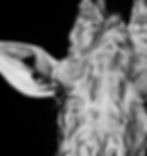Scratchboard Tutorial: Creating Realistic and Soft Fur Textures
- Melissa Helene
- May 20, 2021
- 3 min read
Updated: Dec 23, 2024

Today's post is all about FUR! I use a combination of the small fiberglass brush and an x-acto knife to create realistic looking fur. There are several ways to render fur on scratchboard, but I'm going to talk about my specific processes and methods.
The first step in almost all of my scratchboard textures is the small fiberglass brush. I use this tool to put in the first layer of scratches, which helps establish the flow of the fur (the direction in which the individual hairs grow) and creates a softness that makes it feel real.

When I'm scratching fur, I like to make sure the individual strokes feel random and are not perfectly parallel to one another because it looks more natural and accurate when the piece is complete. Real fur crosses over itself and grows in weird directions, so I like to keep my scratching strokes loose.
This close-up shot of what I was working on in the above video shows you how I work loosely to layer scratches and create a soft fur texture.
[Click to expand the image to see the details closer.]
The fiberglass brush scratches are the 'first' layer, but I may go over one area with that tool a number of times to get the fur growth direction accurate, but also the values correct. If I want an area to be bright or white, I will scratch most of that value in with the fiberglass brush.
The second step of the scratching is done with the x-acto knife and this tool is used to both refine an area (for value and flow) and add the specific, intricate details. I use the x-acto blade to put in individual scratches and really emphasize what is happening with the fur. These individual hairs are not only used for added detail, but they may also emphasize light and highlights in an area.

The detail scratches, depending on the area and the effect I'm attempting to create, will be put in very randomly and loosely or with exact precision. Long, flowy areas of fur are created with loose strokes, while shorter fur or smaller areas may require more care with the scratches.
The fur above the eye in the photo to the left was scratched with loose strokes, while the hair below the eye was scratched in more precisely.
[Click to expand this photo to view the details.]
The combination of a soft base layer, done with the fiberglass brush, and the intricate detailed fur of the top layer, done with the x-acto knife, help create a photo-realistic texture that appears soft and begs the viewer to reach out and touch it (which they might do).
[Another demonstration of how I combine the tools to create fur in my wildlife scratchboard artwork.]
One of the main things to pay attention to when creating photo-realistic scratchboard artwork is the hair growth patterns - which I mentioned briefly above. The direction in which hair and fur grows is incredibly important to creating a realistic looking piece of wildlife art - it is one of those things that will feel 'off' if you get it wrong, but you won't necessarily be able to identify why it looks inaccurate.

This giraffe piece is a great example of how very important (and complicated) the fur growth pattern really can be. Look at how the hair is growing on this giraffe's face...it changes so many times and all over the place. It is crucial to pay attention to the direction changes...especially if your goal is photo-realism or a near accurate representation.
The fur on giraffes and many other animals (horses, zebras, deer, etc) is very short, so the scratching process can look a little different. I still use the tools in the same ways, but each individual stroke with those tools are smaller, shorter, and tighter (think 'hand cramping repetitiveness').

This detail shot of the side of a grizzly bear's head/neck shows you how different the strokes of a fluffier animal are compared to a giraffe or shorter haired animal. The fur patterns are still all over the place (notice the hair swirling in the right middle part of the image), but the scratches are loose and flowy because the hairs are longer.
[Click to expand for a closer look.]
For more information on the fiberglass brush or x-acto knife, check out their respective blog posts.
Thanks so much for following along with my scratchboard fur tutorial and please let me know if you have any questions!
Find Your Joy
-Melissa
Come learn even more with me inside one of my scratchboard courses! There is something for artists of all levels and we start with the foundational basics. Check out the courses!
#scratchboard #blog #blogpost #artblog #artistblog #blogforartists #scratchboardartist #scratchboardhowto #scratchboardlesson #scratchboardtechniques #scratchboardtutorial #tutorial #tutorialvideos #videos #timelapsevideos #melissahelene #melissahelenefinearts #melissahelenescratchboard #wildlifeartist #animalartist #asktheartist #drawinglessons


